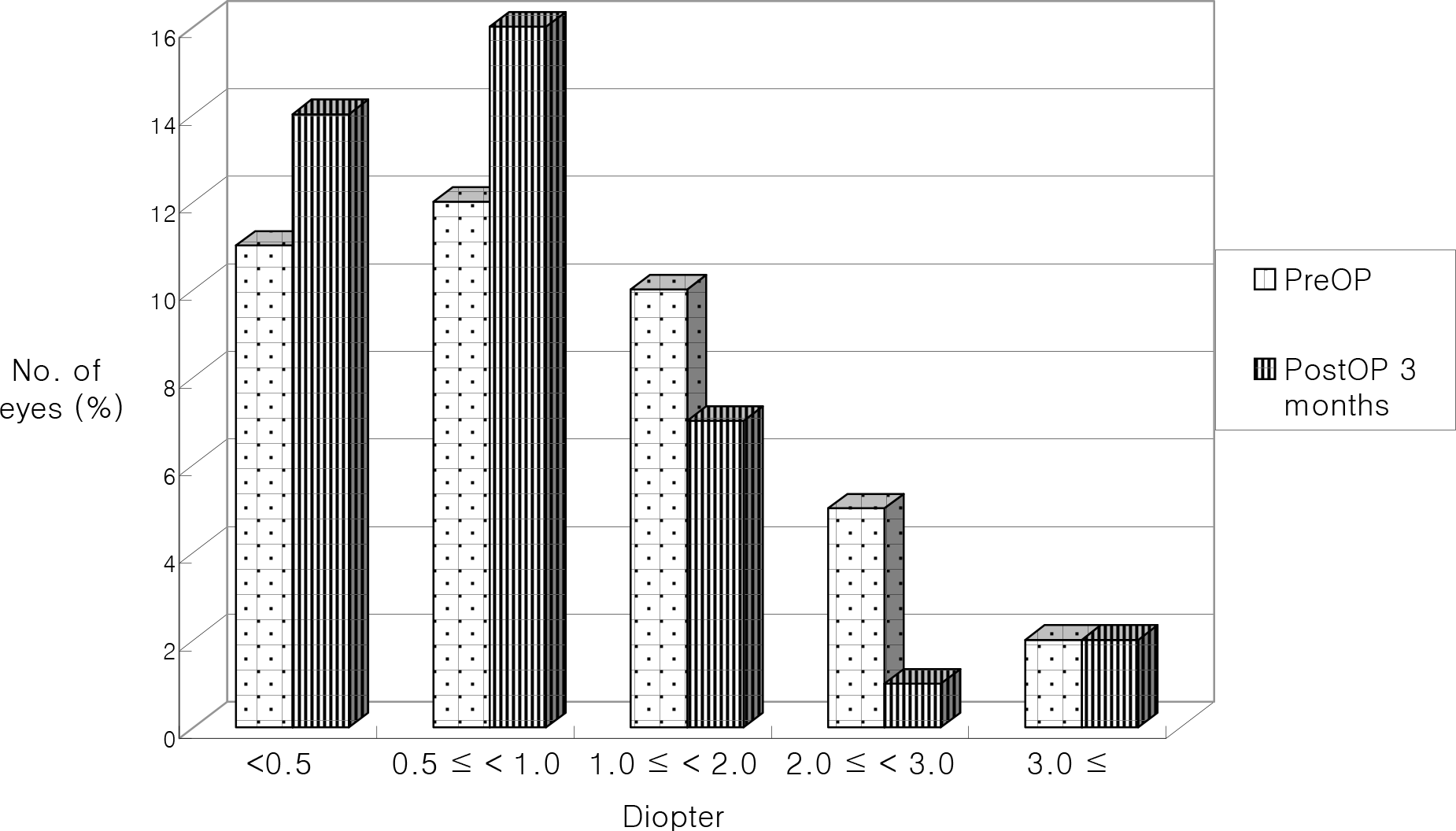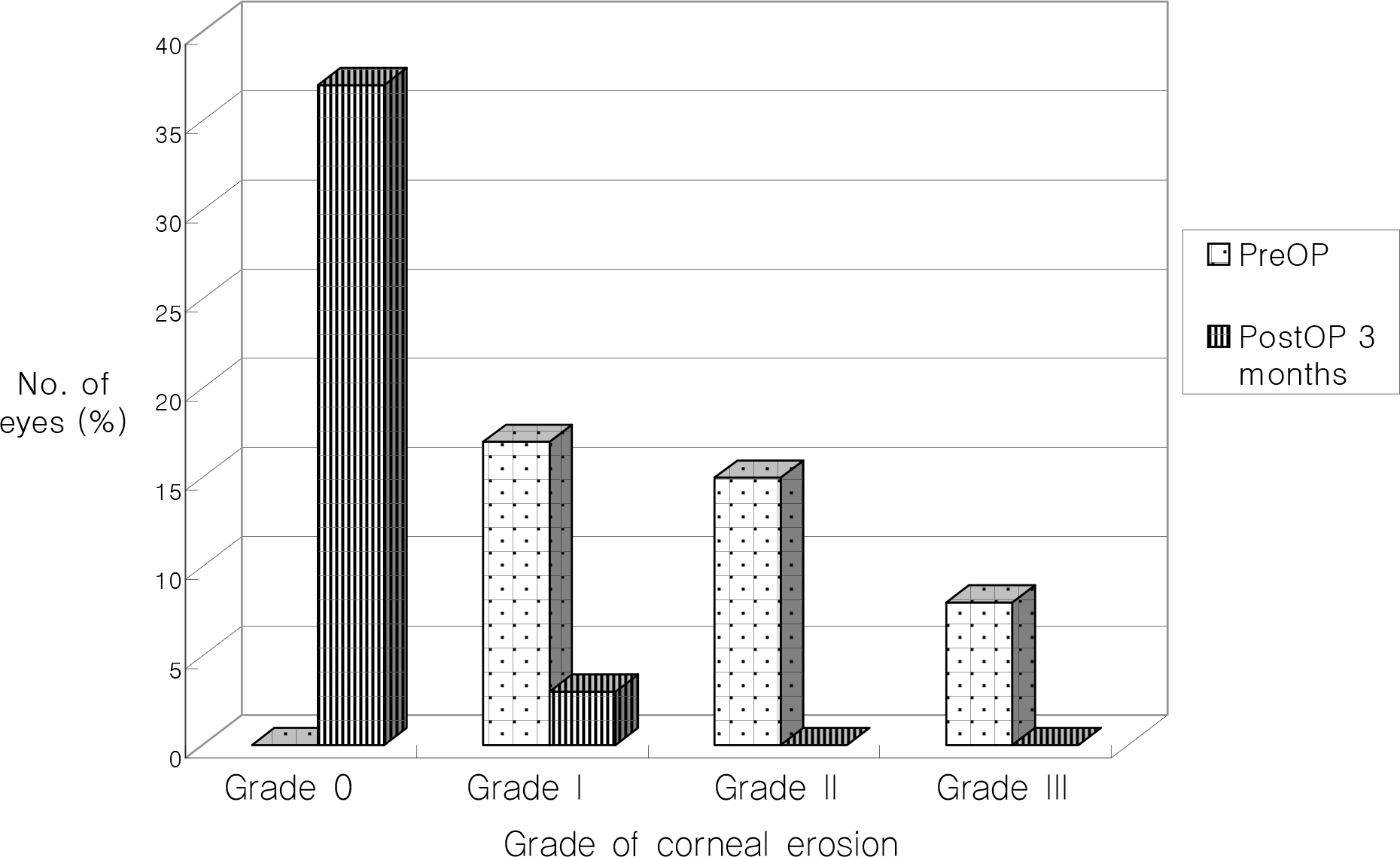Abstract
Purpose
To study the changes in vision and astigmatism in epiblepharon patients undergoing simultaneous surgery for both upper and lower eyelid epiblepharon.
Methods
The study subjects consisted of 40 eyes of 20 patients who underwent surgery for both upper and lower eyelid epiblepharon from March 2007 to December 2008. The patients were divided into groups depending on the degree of corneal erosion. Uncorrected and best corrected vision, refractive error and the degree of corneal erosion were measured before and three months after the surgery.
Results
The mean patient age was 7.40 years, and all but three patients showed postoperative grade 0 corneal erosion. Mean uncorrected logMAR visual acuity was 0.44 preoperatively and 0.25 three months after the operation. The mean best corrected logMAR visual acuity was 0.13 preoperatively and 0.04 three months after the operation (p = 0.02, 0.01). Mean astigmatism showed a significant decrease from 1.46 preoperatively to 1.19 three months after surgery (p = 0.03).
Go to : 
References
1. Noda S, Hayasaka S, Setogawa T. Epiblepharon with inverted eye-lashes in Japanese children. I. Incidence and symptoms. Br J Ophthalmol. 1989; 73:126–7.

2. Preechawai P, Amrith S, Wong I, Sundar G. Refractive changes in epiblepharon. Am J Ophthalmol. 2007; 143:835–9.

4. Khwarg SI, Lee YJ. Epiblepharon of the Lower Eyelid; Classification and association with astigmatism. Korean J Ophthalmol. 1997; 11:111–7.

5. McCord CD, Tanenbaum M, Nunery WR. Oculoplastic Surgery. 3rd ed.New York: RavenPress;1995. p. 221–2.
6. Kim SY, Moon IA, Kang YK, Yang SW. Clinical evaluation of epiblepharon and congenital entropion. J Korean Ophthalmol Soc. 1999; 40:646–51.
7. Lee DP, Kim SD, Hu YJ. Change of visual acuity and astigmatism after operation in epiblepharon children. J Korean Ophthalmol Soc. 2001; 42:223–7.
8. Baek SH, Heo NH, Lee KS. Corneal topographic changes after surgery in epiblepharon children. J Korean Ophthalmol Soc. 2002; 43:1841–6.
9. Karlin DB. Congenital entropion, epiblepharon and antimongoloid obliquity of the palpebral fissure. Am J Ophthalmol. 1960; 50:487–93.

10. Millman AL, Mannor GE, Putterman AM. Lid crease and capsu-lopalpebral fascia repair in congenital entropion and epiblepharon. Ophthalmic Surg. 1994; 25:162–5.

11. Hornblass A. Oculoplastic, Orbital and Rectonstructive Surgery. 1. Baltimore: Williams & Wilkins;1998. p. 17.
12. Hwang JM, Lee JH. Clinical evaluation of epiblepharon. J Korean Ophthalmol Soc. 1988; 29:1–5.
13. Kim JC, Ahn SK, Byun DS, Moon YS. A study on the characteristics of the astigmatism among the school children. J Korean Ophthalmol Soc. 1990; 31:1587–93.
14. Dobson V, Fulton AB, Sebris SL. Cycloplegic refractions of infants and young children: the axis of astigmatism. Invest Ophthalmol Vis Sci. 1984; 25:83–7.
15. Fulton AB, Dobson V, Salem D, et al. Cycloplegic refractions in infants and young children. Am J Ophthalmol. 1980; 90:239–47.

16. Gwiaza J, Scheiman M, Mohindra I, Held R. Astigmatism in children changes in axis and amount from birth to six years. Invest Ophthalmol Vis Sci. 1984; 25:88–92.
17. Jeoung JW, Kim NJ, Choung HK, Khwarg SI. Changes in astigmatism after surgical repair of epiblepharon or ptosis: A vectorial-an-alytic approach. J Korean Ophthalmol Soc. 2005; 46:1429–34.
18. Park SW, Sok JY, Park YG. The effect of surgical correction of epiblepharon on astigmatism in children. J Pediatr Ophthalmol Strabismus. 2008; 45:31–5.

Go to : 




 PDF
PDF ePub
ePub Citation
Citation Print
Print




 XML Download
XML Download